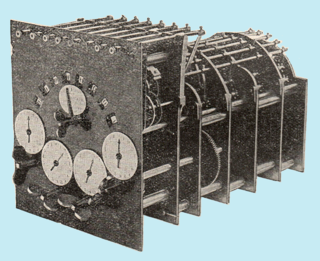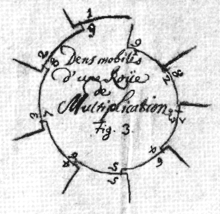
An electronic calculator is typically a portable electronic device used to perform calculations, ranging from basic arithmetic to complex mathematics.

The slide rule is a mechanical calculator hand-operated by sliding two rulers to perform multiplication and division primarily, and possibly exponents, roots, logarithms, and trigonometry. It is not typically designed for addition or subtraction, which is usually performed using other methods, like using an abacus. Maximum accuracy for standard linear slide rules is about three decimal significant digits, while scientific notation is used to keep track of the order of magnitude of results.

An adding machine is a class of mechanical calculator, usually specialized for bookkeeping calculations. In the United States, the earliest adding machines were usually built to read in dollars and cents. Adding machines were ubiquitous office equipment until they were phased out in favor of calculators in the 1970s and by personal computers beginning in about 1985. The older adding machines were rarely seen in American office settings by the year 2000.

Wilhelm Schickard was a German professor of Hebrew and astronomy who became famous in the second part of the 20th century after Franz Hammer, a biographer of Johannes Kepler, claimed that the drawings of a calculating clock, predating the public release of Pascal's calculator by twenty years, had been discovered in two unknown letters written by Schickard to Johannes Kepler in 1623 and 1624.

The Curta is a hand-held mechanical calculator designed by Curt Herzstark. It is known for its extremely compact design: a small cylinder that fits in the palm of the hand. It was affectionately known as the "pepper grinder" or "peppermill" due to its shape and means of operation; its superficial resemblance to a certain type of hand grenade also earned it the nickname "math grenade".

The Comptometer was the first commercially successful key-driven mechanical calculator, patented in the United States by Dorr Felt in 1887.

A mechanical calculator, or calculating machine, is a mechanical device used to perform the basic operations of arithmetic automatically, or (historically) a simulation such as an analog computer or a slide rule. Most mechanical calculators were comparable in size to small desktop computers and have been rendered obsolete by the advent of the electronic calculator and the digital computer.

A slide calculator, also known as an Addiator after the best-known brand, is a mechanical calculator capable of addition and subtraction, once made by Addiator Gesellschaft, Berlin. Variants of it were manufactured from 1920 until 1982. Only made obsolete by the electronic variety, it was simple and cheap for the time.

The arithmometer was the first digital mechanical calculator strong enough and reliable enough to be used daily in an office environment. This calculator could add and subtract two numbers directly and could perform long multiplications and divisions effectively by using a movable accumulator for the result.

Willgodt Theophil Odhner was a Swedish engineer and entrepreneur, working in St. Petersburg, Russia. He was the inventor of the Odhner Arithmometer, which by the 1940s was one of the most popular type of portable mechanical calculator in the world.

Pascal's calculator is a mechanical calculator invented by Blaise Pascal in 1642. Pascal was led to develop a calculator by the laborious arithmetical calculations required by his father's work as the supervisor of taxes in Rouen. He designed the machine to add and subtract two numbers directly and to perform multiplication and division through repeated addition or subtraction.

The stepped reckoner or Leibniz calculator was a mechanical calculator invented by the German mathematician Gottfried Wilhelm Leibniz around 1672 and completed in 1694. The name comes from the translation of the German term for its operating mechanism, Staffelwalze, meaning "stepped drum". It was the first calculator that could perform all four basic arithmetic operations.

The Marchant Calculating Machine Company was founded in 1911 by Rodney and Alfred Marchant in Oakland, California.

Frank Stephen Baldwin was an American who invented a pinwheel calculator in 1875. He started the design of a new machine in 1905 and was able to finalize its design with the help of Jay R. Monroe who eventually bought the exclusive rights to the machine and started the Monroe Calculating Machine Company to manufacture it.

A mechanical computer is a computer built from mechanical components such as levers and gears rather than electronic components. The most common examples are adding machines and mechanical counters, which use the turning of gears to increment output displays. More complex examples could carry out multiplication and division—Friden used a moving head which paused at each column—and even differential analysis. One model, the Ascota 170 accounting machine sold in the 1960s calculated square roots.

Giovanni Poleni was a Marquess, physicist, mathematician and antiquarian.

A Leibniz wheel or stepped drum is a cylinder with a set of teeth of incremental lengths which, when coupled to a counting wheel, can be used in the calculating engine of a class of mechanical calculators. Invented by Leibniz in 1673, it was used for three centuries until the advent of the electronic calculator in the mid-1970s.

The Millionaire was the first commercially successful mechanical calculator that could perform a direct multiplication. It was in production from 1893 to 1935 with a total of about five thousand machines manufactured.

The Odhner Arithmometer was a very successful pinwheel calculator invented in Russia in 1873 by W. T. Odhner, a Swedish immigrant. Its industrial production officially started in 1890 in Odhner's Saint Petersburg workshop. Even though the machine was very popular, the production only lasted thirty years until the factory was nationalised and closed down during the Russian revolution of 1917.

The Arithmaurel was a mechanical calculator that had a very intuitive user interface, especially for multiplying and dividing numbers because the result was displayed as soon as the operands were entered. It was first patented in France by Timoleon Maurel, in 1842. It received a gold medal at the French national show in Paris in 1849. Its complexity and the fragility of its design prevented it from being manufactured.





















